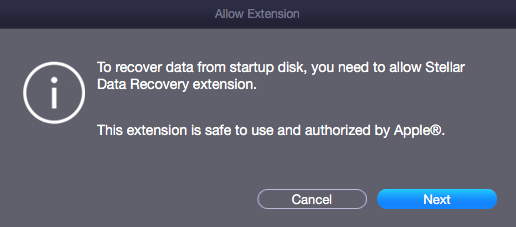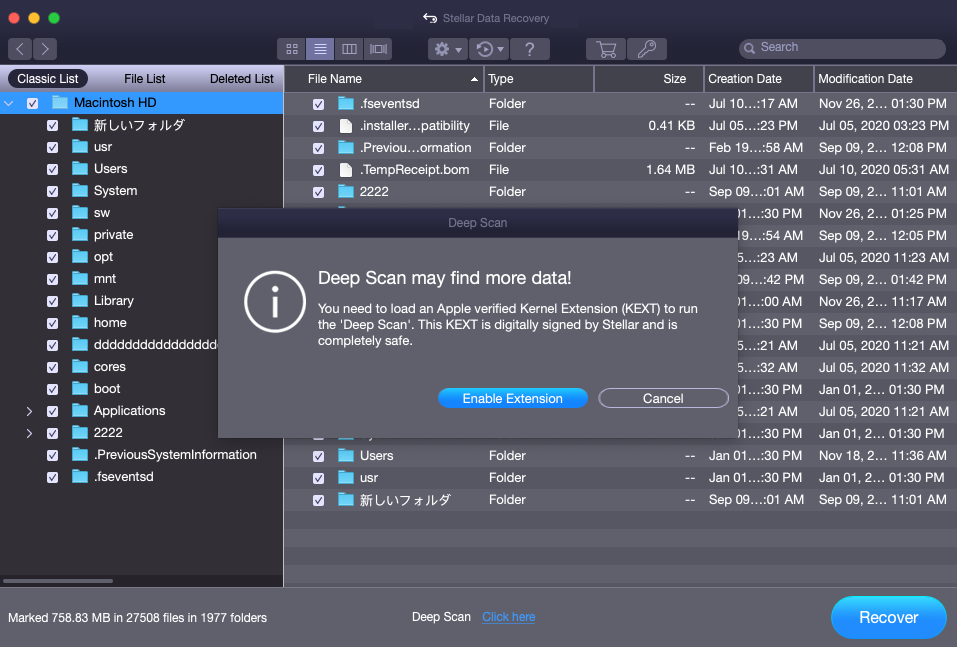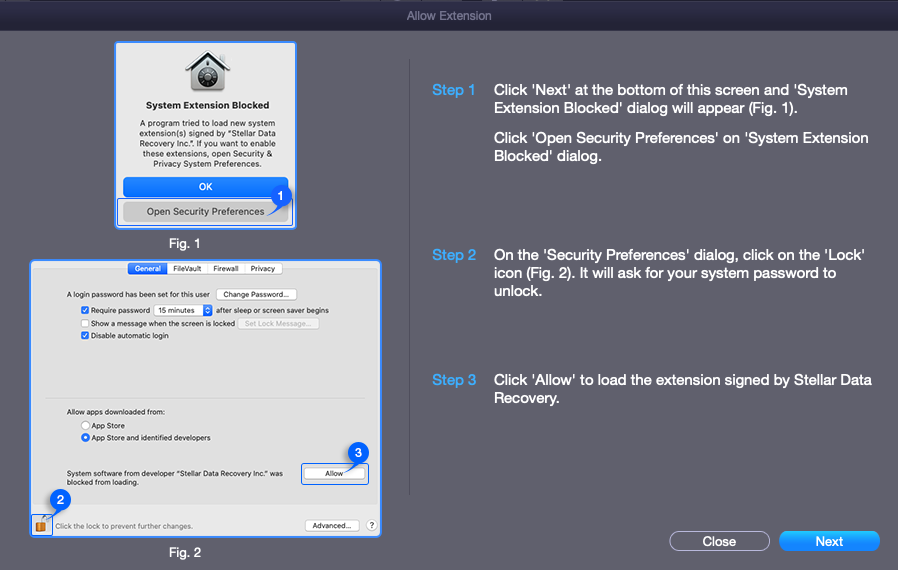Stellar Data Recovery
- 1. About Stellar Data Recovery
- 2. About the Guide
 3. Getting Started
3. Getting Started 4. Working with the Software
4. Working with the Software- 4.1. Recovering Data from Existing Volume
- 4.2. Recovering Data from CD/DVD
- 4.3. Recovering a Lost Partition
- 4.4. Recovering Data from Crashed Computer
 4.5. Working with Disk Images
4.5. Working with Disk Images- 4.6. Previewing the Scan Result
- 4.7. Saving the Recovered Files
 4.8. Performing a Deep Scan
4.8. Performing a Deep Scan- 4.9. Save and Load Scan Information
 4.10. Changing Preferences
4.10. Changing Preferences
- 5. Supported File Types
- 6. Frequently Asked Questions (FAQs)
- 7. About Stellar

4.8.1. Why enable Kernel Extension (KEXT)?
Stellar Data Recovery provides recovery of data from mac models with a T2 security chip. If you have T2 security chip system then you need to allow the software for Kernel Extension (KEXT). KEXT is digitally signed by Stellar® and verified by Apple®. Thus, your system and its privacy are safe.
Note: While performing a deep scan of any volume, Stellar Data Recovery software is required to enable Kernel Extension (KEXT). This process only needs to be set when starting a deep scanning process for the first time.
Steps to allow Kernel Extension (KEXT):
1. Run Stellar Data Recovery.
2. From Select What to Recover screen, select the desired type of data i.e. Documents, Emails, Videos, Audio or Photos you want to recover. The Recover Everything option is turned ON by default. You can also customize your scan by selecting your preferred type.
.png)
3. Click Next.
4. From Recover From screen, select the volume from which you want to recover the data.

5. Select Deep Scan directly from here, if you want to perform a comprehensive scan of the selected volume. Then click on Scan.
Note: If you don't want to select Deep Scan from Recover From screen, then skip Step 6 and directly click on Scan button for quick volume scanning.
6. The Allow Extension dialog box is displayed. Click Next to proceed.
Note: For further instructions on how to Enable Extension, follow the steps mentioned from Step 11.

7. Click Stop button, if you need to abort the scanning process before it is completed.

8. After the scanning process is completed, details of the files and folder found are displayed in a dialog box as shown below:

9. Click OK to finish the process.
10. If you have done a quick scan from Recover From screen and your expected data is not recovered then click on click here link from preview window to perform deep scanning. Deep Scan dialog box is displayed prompting to enable Kernel Extension (KEXT) and then perform a deep scan.

11. Click Enable Extension button, a window appears showing a short procedure to allow the extension. Click Next.

12. System Extension Blocked window is displayed with the application name that requires Kernel Extension (KEXT).

Note: There are two cases when System Extension Blocked window is displayed:
-
Case 1: When your system has a single application that requires Kernel Extension.
-
Case 2: When your system has multiple applications that require Kernel Extension.
For Case 1, follow the instructions given from Step 13 to Step 18.
13. Click Open Security Preferences and wait for the system to open the Security & Privacy settings.
Note: In some cases, if you click OK on the System Extension Blocked dialog box instead of Open Security Preferences, the Stellar Data Recovery might not give you the option to open the Security & Privacy settings when you run scan the next time. In that case, you need to manually open the Security & Privacy settings using the procedure given in How to manually open the Security & Privacy settings in macOS.

14. On the bottom left corner of the window, click the lock ![]() icon.
icon.
15. Use your Touch ID (if available) or enter your system administrator credentials and click Unlock. This enables the Allow button on the Security & Privacy window.
16. Click Allow, allowing macOS to load the extension signed by “Stellar Data Recovery”.

17. Close Security & Privacy window to go back to Stellar Data Recovery.
18. Click Continue on the Allow Extension window to resume your scan of the System Disk.

For Case 2, follow the instructions given from Step 19 to 25:
19. On Allow Extension window, click Next button. If your system has multiple applications that support Kernel Extension then System Extension Blocked window is displayed multiple times with all the available application names.
20. Click Open Security Preferences and wait for the system to open the Security & Privacy settings.

Note: In some cases, like if you click OK on the System Extension Blocked dialog box instead of Open Security Preferences, the Stellar Data Recovery might not give you the option to open the Security & Privacy settings when you run scan the next time. In that case, you need to manually open the Security & Privacy settings using the procedure given in How to manually open the Security & Privacy settings in macOS.
21. On the bottom left corner of the window, click the lock ![]() icon.
icon.
22. Use your Touch ID (if available) or enter your system administrator credentials and click Unlock. This enables the Details button on the Security & Privacy window.

23. Click Details button.
24. A window appears listing the available application names along with a checkbox. Select Stellar Data Recovery Inc. checkbox and click OK.

25. A window is displayed with a message, "A restart is required before new system extensions can be used." Click on Restart button.

How to manually open the Security & Privacy settings in macOS:
In some cases, if you are unable to allow macOS to load the extension in the first attempt, Stellar Data Recovery displays the following dialog box when you scan a system disk the next time.

This means you have to manually open the Security & Privacy settings in macOS. The procedure to open the security settings is given as follows:
1. Click the Apple icon from the top left of your screen and select System Preferences from the drop-down menu.

2. Select Security & Privacy.

3. Follow the steps from Step 14 of the procedure to allow macOS to load an extension signed by “Stellar Data Recovery”.